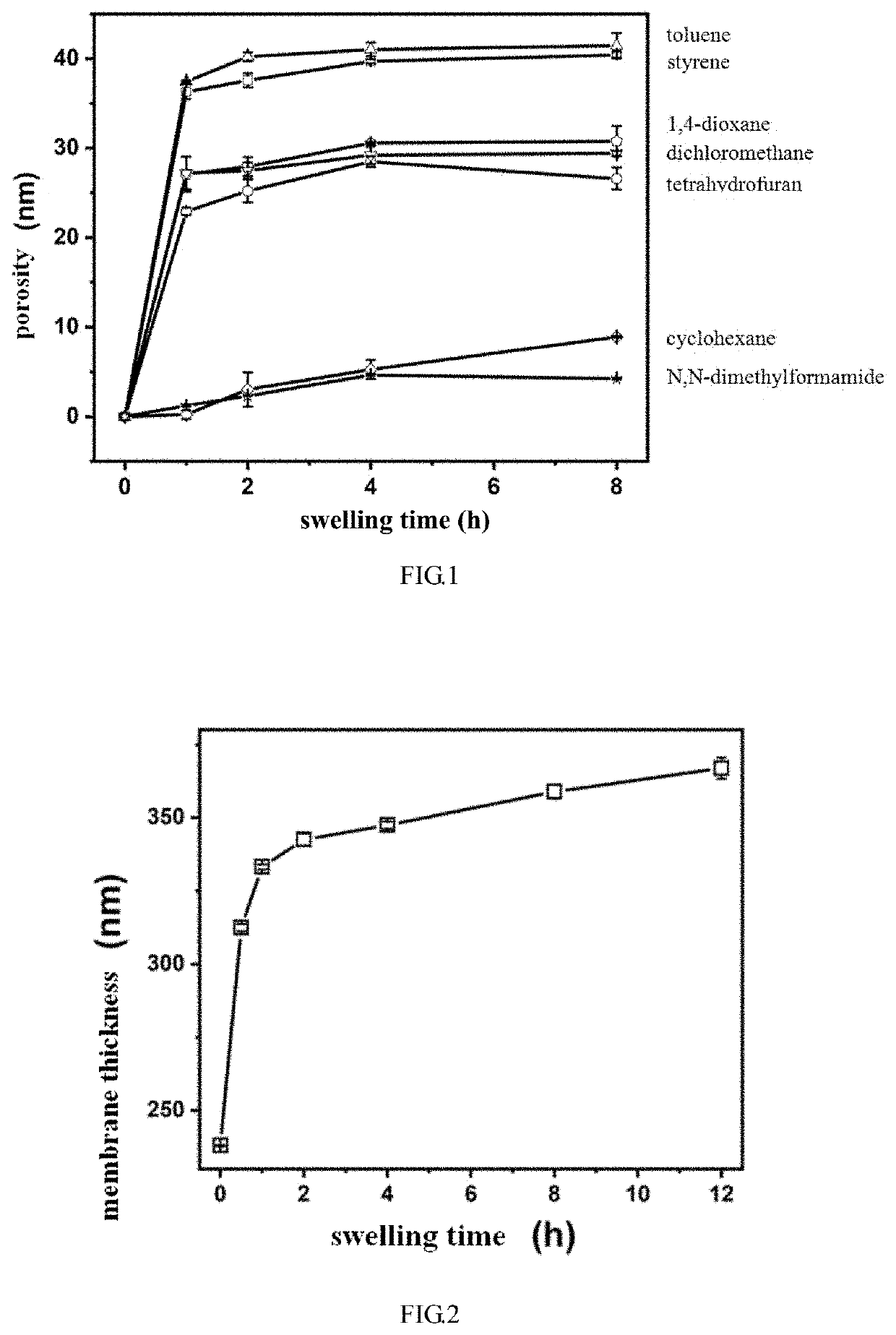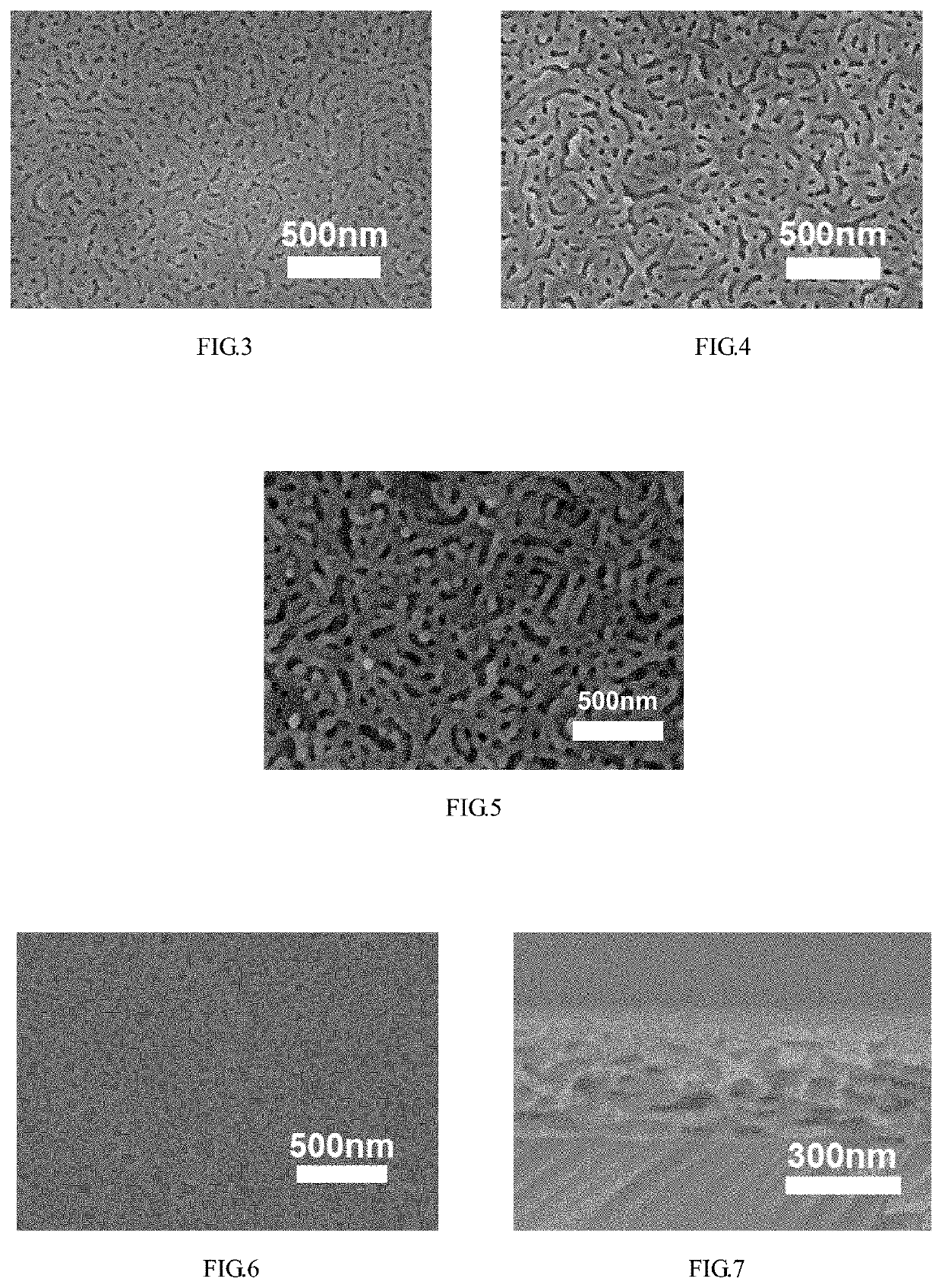Room-temperature selective swelling method of pore-forming used for preparing separation membranes
a pore-forming and room-temperature selective swelling technology, applied in the field of room-temperature selective swelling of pore-forming used in the preparation of separation membranes, can solve the problems of limited practicability of this method, environmental and safety hazards,
- Summary
- Abstract
- Description
- Claims
- Application Information
AI Technical Summary
Benefits of technology
Problems solved by technology
Method used
Image
Examples
example 1
[0071]We add 0.02 g of PS53-P2VP21 block copolymers to 2 g of chloroform solutions and fully stir the solution to dissolve it, then filter the prepared polymer solution with a 200 μm pore-size filter to remove large particles of impurities; take 100 μL of the above solution, then spin-coat it on the silicon wafer substrate at 2000 rpm for 30 seconds, which is next placed at room temperature to naturally become dry for 6 hours, so as to completely volatilize the solvent to obtain a dense membrane of the block copolymer; immerse the membrane in a mixed solution containing ethanol and 1,4-dioxane, in which the volume fraction of 1,4-dioxane is 12%, after soaking the membrane at 20° C. for 1 hour, take it out and leave it at room temperature for drying.
[0072]FIG. 3 is a SEM image of the porous structure of the block copolymer obtained in this example. It can be seen from the figure that if we treat the membrane by the composite swelling agent with a 12% concentration of 1,4-dioxane for ...
example 2
[0074]We add 0.02 g of PS53-P2VP21 block copolymers to 2 g of chloroform solutions and fully stir the solution to dissolve it, then filter the prepared polymer solution with a 200 μum pore-size filter to remove large particles of impurities; take 100 μL of the above solution, then spin-coat it on the silicon wafer substrate at 2000 rpm for 30 seconds, which is next placed at room temperature to naturally become dry for 6 hours, so as to completely volatilize the solvent to obtain a dense membrane of the block copolymer; immerse the membrane in a mixed solution containing ethanol and 1,4-dioxane, in which the volume fraction of 1,4-dioxane is 12%, after soaking the membrane at 20° C. for 8 hour, take it out and leave it at room temperature for drying.
[0075]FIG. 4 is a SEM image of the porous stmcture of the block copolymer obtained in this example. It can be seen from the figure that if we treat the membrane by the composite swelling agent with a 12% concentration of 1,4-dioxane for ...
example 3
[0077]We add 0.02 g of PS53-P2VP21 block copolymers to 2 g of chloroform solutions and fully stir the solution to dissolve it, then filter the prepared polymer solution with a 200 μm pore-size filter to remove large particles of impurities; take 100 μL of the above solution, then spin-coat it on the silicon wafer substrate at 2000 rpm for 30 seconds, which is next placed at room temperature to naturally become dry for 6 hours, so as to completely volatilize the solvent to obtain a dense membrane of the block copolymer; immerse the membrane in a mixed solution containing ethanol and 1,4-dioxane, in which the volume fraction of 1,4-dioxane is 16%, after soaking the membrane at 20° C. for 4 hour, take it out and leave it at room temperature for drying.
[0078]FIG. 5 is a SEM image of the porous stmcture of the block copolymer obtained in this example. It can be seen from the figure that if we treat the membrane by the composite swelling agent with a 16% concentration of 1,4-dioxane for 4...
PUM
| Property | Measurement | Unit |
|---|---|---|
| Temperature | aaaaa | aaaaa |
| Temperature | aaaaa | aaaaa |
| Fraction | aaaaa | aaaaa |
Abstract
Description
Claims
Application Information
 Login to View More
Login to View More - R&D
- Intellectual Property
- Life Sciences
- Materials
- Tech Scout
- Unparalleled Data Quality
- Higher Quality Content
- 60% Fewer Hallucinations
Browse by: Latest US Patents, China's latest patents, Technical Efficacy Thesaurus, Application Domain, Technology Topic, Popular Technical Reports.
© 2025 PatSnap. All rights reserved.Legal|Privacy policy|Modern Slavery Act Transparency Statement|Sitemap|About US| Contact US: help@patsnap.com



